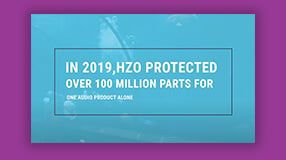Polyurethane Conformal Coatings - Benefits & Applications

Conformal coatings are polymeric materials applied to a PCB to improve device reliability. These films protect electronics from environmental threats, including humidity, liquids, and corrosive substances.
Different conformal coating materials include acrylic coatings, silicone, epoxy, and Parylene. Polyurethane is another common conformal coating material.
Learn how to choose the best conformal coating
Polyurethane coatings are tough, hard, protective layers that resist solvents and abrasion.
Polyurethane conformal coatings have the following attributes:
- Moisture and oil-resistant
- Fungicidal
- Good flexibility
- Can be thinned to achieve a chosen viscosity
- Class F temperature rating (160°C/320°F)
-
Retain excellent electrical insulation properties after the MIL-I-46058 cycling test.
What are the Benefits of Polyurethane Conformal Coating?
Polyurethane can enhance devices. It extends their life and ensures they work reliably in any location.
These coatings exhibit sturdiness and strong resistance to humidity and organic solvents. The tough coatings are resistant to mechanical wear. Additionally, polyurethane can mitigate the growth of tin whiskers.

Polyurethane Conformal Coatings Applications
Polyurethane coatings are ideal in areas with excessive chemical exposure.
Urethane coatings protect and insulate motors, generators, relays, transformers, and other components. This coating material is also common in automotive and aerospace environments. Urethane coatings protect these electronics from chemicals and salt sprays throughout temperature fluctuations.
Learn about protective coatings vs potting
What Do Polyurethane Conformal Coatings Protect Against?
The coatings protect electronics from thermal shock, moisture, chemical solvents, and other elements. Polyurethane has a higher abrasion resistance compared with other materials.
The Polyurethane Conformal Coating Process
Polyurethane comes in single and two-component formulas. You can apply it by dipping, spraying, or brushing. After application, the films are cured to finish the coating. This takes one hour to several days. Single-component urethanes are easy to apply but take up to several days to complete. Meanwhile, two-component formulations cure within hours. The process length is also related to temperature. It cures faster at moderately elevated temperatures. UV curing, heat-catalyzed, and moisture curing are common methods to cross-link urethane polymers.
HZO’s coating process differs because we use vacuum deposition with Parylene coatings. To learn more, watch this video:
View a webinar about designing conformal coatings for reliability
Polyurethane Disadvantages
Curing takes time. It needs a long post-cure time. Moisture affects the cure rate and its properties. The coating can also turn yellow with age.
We compare polyurethane's advantages and disadvantages below:
Polyurethane Conformal Coating Pros and Cons:
Polyurethane Advantages:
- Good flexibility, particularly at low temperatures.
- Excellent chemical resistance.
- Good abrasion resistance.
- Can be removed using special products.
- Can have high tensile strength depending on formulations
Polyurethane Disadvantages:
- Higher water absorption rate than Parylene, acrylics, and silicones.
- Difficult to remove.
- Curing process can be long.
- Low melting point.
- Moisture can impact cure rate and cured properties.
- Long post-cure time to reach full properties.
- Potential to stress components during temperature cycling.
- Can yellow with age.
The Big Picture
Choosing a conformal coating requires more than just the material and methods. We must consider several factors. These include the components' complexity, environmental regulations, and coating rework and removal. Repeatable processes that avoid defects may be important, especially for high-reliability applications.
Please read our definitive guide to choose the best conformal coating for your PCB. If you need more help, contact our Applications Engineering team for a consultation. You can also learn more about coatings' protection capabilities.
Epoxy Conformal Coating Evaluation Guide
Conformal Coating Removal - How to Get Started W/Reference
6 Common Conformal Coating Defects & Their Solutions
Mallory is a veteran writer with over a decade of writing experience and has spent over five years at HZO learning about coating technology from the best minds in the industry. Professionally, Mallory is especially interested in the process of problem-solving and watching how the engineering team develops solutions that ensure business requirements are met. Over her years at HZO, Mallory's writing has been cited in industry whitepapers, including "Parabolic Model for Optimum Dry Film Thickness (DFT) of Corrosion Protective Coatings" and "Universal Approach to Integrating Reduced Graphene Oxide into Polymer Electronics." All of Mallory’s blogs are reviewed for accuracy before publication.
Additional Resources

Which is Better For Your Application? Conformal Coating or Potting?

Learn About Common Conformal Coating Defects And How To Fix Them

Learn How To Incorporate Conformal Coating Into Your Manufacturing Process









